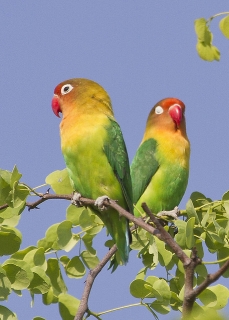Lilian’s Lovebird |
|
|
Also known as: Nyasa Lovebird
Photos
View in GalleryDid You Know?
The nest of Lilian's Lovebird is a bulky, domed structure with an entrance tube made from bark strips, twigs and stems.Programs & Projects
WPT has worked with numerous partners to help save this species. Learn moreAcademic Research
Related publications: Agapornis lilianaeSpecies Profile
Genus: Agapornis | Species: lilianae
Size:
13.5cm (5.3 in)
Weight:
28-37g (1.0-1.3 oz)
Subspecies including nominate:
one
Colour Adult:
Both adults orange/red forehead and throat, mixing into salmon-pink on crown, face and upper breast; green upper tail coverts; green tail, the lateral feathers black at base, with yellow/orange border and banded black near tip. Bill bright red. Eye dark red/brown.
Colour Juvenile:
In general duller than adults, with varying black wash on cheeks. Upper mandible black at base.
Call:
Calls are high-pitched and twittering in flight or when perched.
Listen NowVideo Links:
Video 1More Information:
Avibase
Lovebirds: New in Paradise
Content Sources:
CITES
BirdLife International
xeno-canto Lilian's Lovebird, Solomon, Derek, XC
A Guide to Parrots of the World, Juniper and Parr, 1998
Cornell Lab of Ornithology/Birds of the World
Parrots of the World, Forshaw and Cooper, 1989.
Parrots of the World, Forshaw, 2006.
Photos
View in GalleryDid You Know?
The nest of Lilian's Lovebird is a bulky, domed structure with an entrance tube made from bark strips, twigs and stems.Programs & Projects
WPT has worked with numerous partners to help save this species. Learn moreAcademic Research
Related publications: Agapornis lilianaeSpecies Care
Captive Status:
Rare
Longevity:
Not recorded.
Housing:
Single pair in avairy 2 x 1 x 2m (6.5 x 3.3 x 6.5 ft) or large birdroom cage; three or more pairs in communal enclosure, 1 square metre (11 square feet) per pair. New birds no less than 20C (68 F).
Diet:
Seed mix such as: millet, canary, and some niger, sunflower and hemp; millet spray (dry or sprouted), seeding grasses; green leaves such as: Swiss chard, lettuce, kale, sowthistle, dandelion, chickweed; fruit such as: apple, pear, banana, orange, pomegranate, cactus fruits, figs; vegetables such as: carrot, celery, green beans and peas in the pod; sprouted beans; softened rusk and eggfood for rearing; vitamin and mineral supplements; complete kibble.
Enrichment:
Vigorous chewer so provide plenty of unsprayed, bird-safe flowering, fir, pine, willow, beech or elder branches, wooden block or vegetable tanned leather chew toys, heat sterilized pine cones. Also enjoys bathing so provide overhead misters or shallow water bowls.
Nest Box Size:
Vertical box 15cm x 15cm x 25cm (6 x 6 x 10 in) with fresh branches for the birds to peel the bark off.
Clutch Size:
3-8
Incubation Time:
21-22 days
Fledging Age:
35 days
Hatch Weight:
Not recorded.
Peak Weight:
Not recorded.
Weaning Weight:
Not recorded.
Photos
View in GalleryDid You Know?
The nest of Lilian's Lovebird is a bulky, domed structure with an entrance tube made from bark strips, twigs and stems.Programs & Projects
WPT has worked with numerous partners to help save this species. Learn moreAcademic Research
Related publications: Agapornis lilianaeSpecies Wild Status
World Population:
10,000-20,000, 4000 of which are estimated to be in Liwonde National Park.
IUCN Red List Status:
Near Threatened
CITES Listing:
Appendix II
Threat Summary:
This species is threatened by loss of mature Mopane woodland habitat, persecution by farmers, capture for local and international wild bird trade and indiscriminate poisoning of waterholes used for drinking.
Range:
Isolated populations in S Tanzania, Zambia-Zimbabwe border district, NW Mozambique, S Malawi and SE Zambia to N Zimbabwe. Possibly introduced in Lundazi district, NE Zambia.
Habitat:
Found up to 1000m (3280 ft) in mopane and Acacia sp. woodland in alluvium and in riparian fig tree forest in river valleys.
Wild Diet:
Feeds on grass seeds including Hyparrhenia, millet and wild rice (Oryza perennis) and various others; flowers and/or seeds or fruit of Acacia albida, Erythrophleum africanum, Vitex duamiana and wild mango (Cordyla africana), millet, sorghum and leaf buds.
Ecology and Behaviour:
Very social, gathering in noisy flocks of 20-100 birds and more, particularly where food is abundant. Non-breeding birds form communal roosts in tree hollows where five birds at a time sleep, hanging on to walls of the chamber. Before retiring for the night there is much squabbling and chasing to and fro. Foraging is directly from plant and on the ground.
Clutch and Egg Size:
3-8 slightly elliptical eggs, 20.5 x 16.5mm (0.8 x 0.6 in).
Breeding Season:
January-July in Zambia and Dec-May in Malawi; nest a roofed structure in crevices in mopane trees.
Related Links:
Wikipedia
Article: The drinking habits of Lilian's Lovebird and incidents of poisoning at waterholes
Photos
View in GalleryDid You Know?
The nest of Lilian's Lovebird is a bulky, domed structure with an entrance tube made from bark strips, twigs and stems.Programs & Projects
WPT has worked with numerous partners to help save this species. Learn moreAcademic Research
Related publications: Agapornis lilianaeMembers Only Resources
Please log-in now to find more research, resources and tools.
Not a Member?
Find more great information:
Gain exclusive access to 600+ pages of additional research, seminars and podcasts, specialists to ask your toughest questions, and dozens of other fun resources - when you become a WPT member.
Join Today >>

































